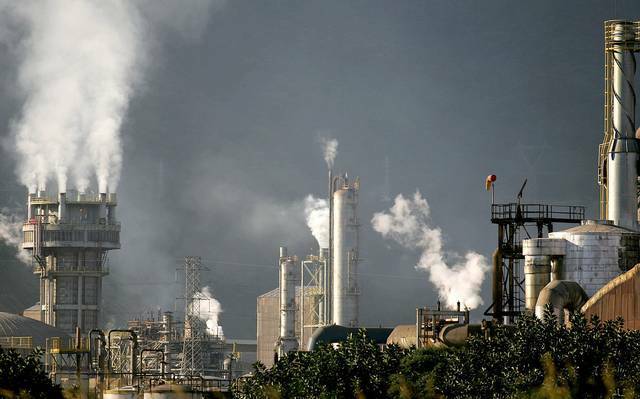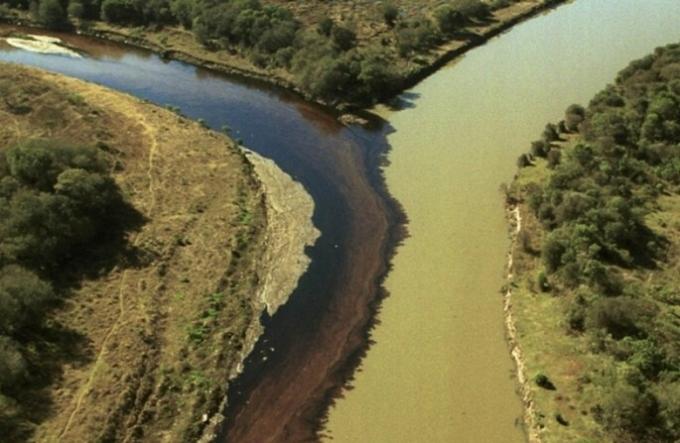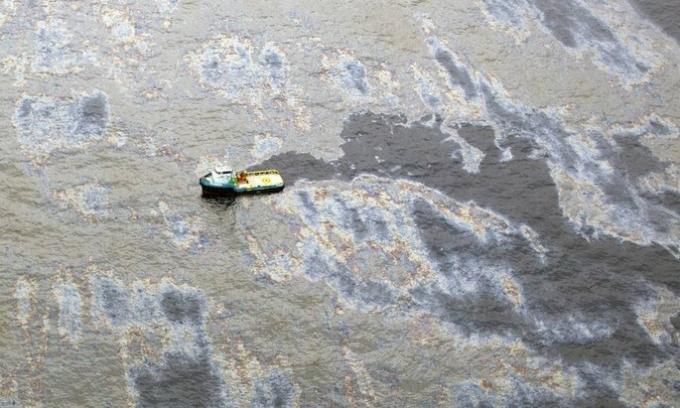In Brazil, unfortunately we have several examples of environmental disasters that directly affected the environment and the population of many states.
Check below a list of the main environmental disasters that occurred in the country.
1. Oil spill from the oil tanker Tarik Iba Ziyad in Guanabara Bay (1975)
- Location: Guanabara Bay, in the state of Rio de Janeiro
- Date: March 1975
- Quantity: 6 thousand tons of crude (oil)
The biggest oil spill accident in Brazil happened in the mid-1970s by the oil tanker Tarik Iba Ziyad, which was being chartered by Petrobras.
This happened because the ship's hull was broken in front of Botafogo inlet, close to Governador Island.
The result was a 10 centimeter-thick stain that appeared in some points of Guanabara Bay. Due to the accident, some places also caught fire.
2. Death Valley in Cubatão (1980)
- Location: Cubatão, interior of the state of São Paulo
- Date: year 1980
- Cause: release of toxic gases by the industries of the petrochemical complex in Cubatão
In the 1980s, the city of Cubatão, in the interior of São Paulo, was considered one of the most polluted in the country and the most polluted city in the world, according to UN data.
The increase in the population's health problems, especially those associated with the respiratory system, and the number of mortality became one of the most significant in the country.

This was all a consequence of the industries in the Cubatão petrochemical complex that polluted the region's air, water and soil, as tons of toxic gases were released daily.
This case reached international proportions being cited in several media outlets at the time. Including the name "Death Valley" (valley of death, in English) was created by an American newspaper.
3. Fire in the Vila de Socó in Cubatão (1984)
- Location: Vila São José, in Cubatão, in the interior of the state of São Paulo
- Date: February 24, 1984
- Deaths: 93 people (official number)
- Quantity: 700 thousand liters of gasoline
- Guilty Company: Petrobras
A large fire in Socó, now Vila de São José in Cubatão, was caused by a gasoline leak in one of Petrobras' pipelines.
Due to an operational failure, the pipeline ruptured and 700,000 liters of gasoline spilled into the site. About 2 hours later, a large fire engulfed the mangrove swampy area.
All the houses that were close to the site were set on fire and more than 3,000 people were left homeless. Although the official death toll is 93, residents believe that more than 500 people died in that fire.
4. Accident with cesium-137 in Goiânia (1987)
- Location: Goiânia, capital of the state of Goiás
- Date: September 13, 1987
- Deaths: 4 people
- Quantity: 19.26 g of Cesium
- Guilty Company: Goiano Radiotherapy Institute
The biggest radiological accident in Brazil happened in 1987 in the city of Goiânia. Two garbage collectors in the region found a radiotherapy device in an abandoned clinic.
In order to sell the parts and earn some money, they took the device to a junkyard in the city. The site worker dismantled the device and inside it was a capsule with the radioactive element of Cesium.

The consequences came shortly afterwards, when people who had come into contact with the element began to feel dizzy and vomiting.
It was only days after the first contact, on September 29, that the case was confirmed and an emergency plan triggered. Despite only having 4 fatalities, many people were contaminated and suffered from the radiation levels.
Learn more about Accident with cesium-137 in Goiânia.
5. Oil spill in Guanabara Bay (2000)
- Location: Guanabara Bay, in the state of Rio de Janeiro
- Date: January 18, 2000
- Quantity: 1.3 million liters of fuel oil
- Guilty Company: Petrobras
Considered one of the biggest environmental accidents in Brazil, the oil spill that happened in the Bay of Guanabara in 2000 and reached about 25 beaches, occurred due to the rupture of a pipeline from Petrobras. In total, 1.3 million liters of fuel oil leaked.
The pipe that connected the Duque de Caxias Refinery (Reduc) to the Ilha d'Água terminal, on Ilha do Governador, was ruptured, reaching the entire mangrove area, which was completely destroyed and contaminated.
The oil slick spread for about 50 km2 in Guanabara Bay and directly affected the work of many families who made their living from fishing, in addition to the local ecosystem.
6. Oil leakage in the Barigui and Iguaçu Rivers in Paraná (2000)
- Location: metropolitan region of Curitiba, capital of Paraná
- Date: July 16, 2000
- Deaths: 1 person
- Quantity: 4 million liters of oil (more than 25 thousand barrels)
- Guilty Company: Petrobras
The biggest environmental accident in the state of Paraná happened in the metropolitan region of Curitiba in 2000.
One of the pipelines was ruptured during the transfer of oil from the San Francisco maritime terminal do Sul, in Santa Catarina, for the Presidente Getúlio Vargas Refinery (Repar), in Araucária, in the Paraná.

The result was the leakage of 4 million liters of oil in the Arroio Saldanha basin and the Barigui and Iguaçu rivers.
The consequences of this accident were devastating for the local ecosystem, affecting the fauna and flora, as well as the populations that lived close to the region.
7. Wreck of platform P-36 in Campos Basin (2001)
- Location: Campos Basin, in the interior of the state of Rio de Janeiro
- Date: March 15-18, 2001
- Deaths: 11 people
- Quantity: 1500 tons of oil on board
- Guilty Company: Petrobras
The sinking of the Petrobras P-36 platform was considered one of the biggest disasters in the history of the Brazilian oil company. It took place in 2001 in the Campos Basin, in the interior of Rio de Janeiro.
On that day, the oil production platform, which was the largest so far, had 175 people on board.
The accident began with the explosion of some columns in the early hours of March 15th. In total, there were 3 explosions that caused the death of 11 people.
Gradually, the platform was submerged in the waters and finally sank completely on March 18th. The main problems associated with this tragedy were: errors in maintenance and failures in operating procedures.
8. Disruption of the dam in Cataguases (2003)
- Location: Cataguases, in the interior of the state of Minas Gerais
- Date: March 29, 2003
- Quantity: one billion and four hundred million liters of bleach (black liquor)
- Company guilty: Industry Cataguases de Papel
Considered one of the biggest environmental disasters in Brazil, the collapse of the dam at Fazenda Bom Destino, in the Minas Gerais municipality of Cataguases, took place in 2003.
The dark colored liquid that leaked into the waters of the Paraíba do Sul Hydrographic Basin was the industrial surplus of pulp production. In total, there were 900,000 cubic meters of dark colored industrial tailings, known as “black liquor”.

The result was more than 600,000 people without water for weeks, which directly affected the lives of fishermen, farmers and entire families living in the area.
The accident affected 3 states in Brazil (Minas Gerais, Espírito Santo and Rio de Janeiro), and in addition to the damage caused to human beings, the ecosystem was devastated, affecting the local fauna and flora.
9. Failure of Bom Jardim dam in Miraí (2007)
- Location: Miraí, countryside of the state of Minas Gerais
- Date: January 10, 2007
- Quantity: 200 thousand liters of clay mud
- Company guilty: Rio Pomba Mineração (Bauminas Group)
The accident that happened in January 2007 at the Bom Jardim dam, in the interior of Minas Gerais, was an environmental disaster of major proportions.
The dam leak affected thousands of people and caused great damage to the environment as the death of thousands of fish.
Residents of the region had their homes flooded with toxic mud, with bauxite residues, and many agricultural sites were also affected. In addition, the accident affected the water supply of some neighboring cities such as Laje do Muriaé, in the state of Rio de Janeiro.
10. Oil spill in the Campos Basin (2011)
- Location: Campos Basin, in the interior of Rio de Janeiro
- Date: November 9, 2011
- Quantity: 3700 barrels of oil
- Guilty company: American oil company Chevron
One of the oil spills in the Campos Basin, in the interior of Rio de Janeiro, happened in 2011 due to an unsuccessful drilling of the well in the Frade field carried out by the American oil company Chevron.
Survey results show that it was a mistake made by the oil company, as the site could not have been drilled due to the existing pressure.

The result of this environmental disaster was disastrous for the fauna of the environment, however, as it happened far from the coast, it did not directly affect populations in nearby cities.
One of the company's plans was against the correct cleaning of the site, as instead of removing the oil from the ocean, it was sunk.
11. Fire at Ultracargo in the Port of Santos (2015)
- Location: Santos, coast of the state of São Paulo
- Date: April 2-9, 2015
- Quantity: 60 thousand m3 of fuel (6 tanks)
- Company guilty: Terminal Químico de Aratu S/A, subsidiary of Ultracargo
One of the biggest fires in Brazil occurred in 2015 in the industrial area of Santos. The disaster happened during the transfer of gasoline and ethanol fuel tanks. At that time, there was an operational error that caused one of the valves to explode.
As a result, 6 tanks caught fire, each of which had a capacity of 10,000 m3 of fuel. This generated a huge fire that lasted eight days until it was completely extinguished.
Fortunately, all workers involved in the flames containment process were unharmed. However, inhabitants of nearby areas suffered from respiratory problems.
The environmental damage caused directly affected the quality of air, soil and water. The water used to fight the fire was drained into the sea again, causing the death of 9 tons of fish.
12. Disruption of the Fundão dam in Mariana (2015)
- Location: Mariana, countryside of the state of Minas Gerais
- Date: November 5, 2015
- Deaths: 19 people
- Quantity: 62 million m3 of mud
- Guilty Company: Samarco
Considered the biggest environmental tragedy in Brazil so far, this event took place in 2015 in the city of Mariana, Minas Gerais.
The collapse of the Fundão Dam, used to store iron ore tailings, resulted in the death of 19 people and the contamination of the river, the soil, the sea and the destruction of the flora.
The small town of Bento Rodrigues, located 8 km from the dam, disappeared into the mud minutes after the break.

For 16 days since the beginning of the tragedy, the mud reached more than 40 municipalities in the states of Minas Gerais and Espírito Santo until it reached the Atlantic Ocean.
The residents of these localities suffered from the water supply, fishing was prohibited and more than two thousand hectares of land were affected and rendered useless for planting.
Understand everything about the Mariana's disaster.
13. Disruption of the Mina do Feijão dam in Brumadinho (2019)
- Location: Brumadinho, countryside of the state of Minas Gerais
- Date: January 25, 2019
- Deaths: 259 people
- Quantity: 12 million cubic meters of tailings
- Guilty company: Vale S.A. (former Vale do Rio Doce Company - CVRD)
Considered one of the biggest environmental disasters in Brazil, the collapse of the dam in the mining town of Brumadinho happened in early 2019 at Mina Córrego do Feijão.
The site housed the mining company's tailings and the result was the death of 259 people, mainly company employees, and around 15 people were missing.
The avalanche of toxic sludge hit the municipality of Brumadinho and the Paraopeba River, which supplied water to local communities.
The environmental impact of this disaster was enormous, with pollution of the soil, water courses, fauna and flora in the area.
Keep studying about the topic:
- Environmental disasters: what they are, causes, consequences and examples
- Natural disasters
- Environmental impacts
- Environmental problems in Brazil
- Exercises on environmental problems


